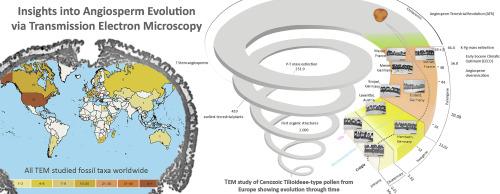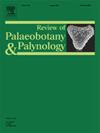The use of transmission electron microscopy when investigating fossil angiosperm pollen: A review and suggestions for future applications
IF 1.7
3区 地球科学
Q2 PALEONTOLOGY
引用次数: 0
Abstract
It has been more than 65 years since transmission electron microscopy (TEM) was first used to study fossil angiosperm pollen. Since then, significant progress has been made in sample preparation protocols and TEM equipment, particularly in contrasting methods used to reveal detailed ultrastructural differences in pollen walls, as well as sensitive, high-resolution cameras needed for documentation. Early TEM studies on fossil angiosperm pollen focused on determining whether ultrastructure could be used to assign palynomorphs to spore-producing plants, gymnosperms, or angiosperms. Later research became more taxonomically focused, comparing fossil pollen walls to those of extant angiosperms. Most TEM research on fossil angiosperm pollen has until now been conducted in the USA, Western/Central Europe, and Russia, with limited contributions from other parts of the scientific community. There is a clear relation between the sample origin (country, locality) and author group, and between the type of pollen specimens (dispersed versus in situ) and the taxonomic resolution. In situ pollen from fossil flowers is usually assigned to families and genera, while most dispersed pollen is noted as Incertae sedis. Despite the obvious advantages of TEM analyses for determining the taxonomic placement and phylogenetic relations of fossil pollen, little effort has been put into this subject over the last decades. To increase the understanding of angiosperm evolution, TEM investigations of fossil pollen need to be routinely applied. New generations of palynologists need to pick up on this method, and an effort to investigate Cenozoic angiosperm pollen from a taxonomic point of view is overdue.

透射电镜在被子植物花粉化石研究中的应用:综述及未来应用的建议
透射电子显微镜(TEM)首次用于研究被子植物花粉化石已有65多年的历史。从那时起,在样品制备方案和TEM设备方面取得了重大进展,特别是在用于揭示花粉壁详细超微结构差异的对比方法,以及用于记录的灵敏、高分辨率相机方面。早期对被子植物化石花粉的透射电镜研究主要集中在确定超微结构是否可以用来为产孢植物、裸子植物或被子植物分配花粉形态。后来的研究更加注重分类学,将化石花粉壁与现存被子植物的花粉壁进行比较。迄今为止,大多数被子植物化石花粉的透射电镜研究都是在美国、西欧/中欧和俄罗斯进行的,其他科学界的贡献有限。样品来源(国家、地区)与作者群体之间、花粉标本类型(分散与原位)与分类分辨率之间存在明显的关系。来自化石花的原位花粉通常被划分为科和属,而大多数分散的花粉被称为Incertae sedis。尽管TEM分析在确定花粉化石的分类位置和系统发育关系方面具有明显的优势,但在过去的几十年里,这方面的研究很少。为了增加对被子植物进化的理解,需要常规应用透射电镜对化石花粉进行研究。新一代的孢粉学家需要学习这种方法,从分类学的角度研究新生代被子植物花粉的努力已经过期。
本文章由计算机程序翻译,如有差异,请以英文原文为准。
求助全文
约1分钟内获得全文
求助全文
来源期刊
CiteScore
3.50
自引率
21.10%
发文量
149
审稿时长
6 months
期刊介绍:
The Review of Palaeobotany and Palynology is an international journal for articles in all fields of palaeobotany and palynology dealing with all groups, ranging from marine palynomorphs to higher land plants. Original contributions and comprehensive review papers should appeal to an international audience. Typical topics include but are not restricted to systematics, evolution, palaeobiology, palaeoecology, biostratigraphy, biochronology, palaeoclimatology, paleogeography, taphonomy, palaeoenvironmental reconstructions, vegetation history, and practical applications of palaeobotany and palynology, e.g. in coal and petroleum geology and archaeology. The journal especially encourages the publication of articles in which palaeobotany and palynology are applied for solving fundamental geological and biological problems as well as innovative and interdisciplinary approaches.

 求助内容:
求助内容: 应助结果提醒方式:
应助结果提醒方式:


